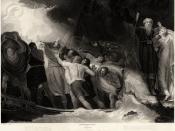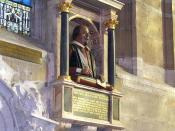"The Tempest", written by William Shakespeare (1564-1616), is an Elizabethan romance that combines the conventions of drama with that of Shakespearean comedies. The 'tempest' in the title refers to both the tremendous storm that opens the play and the emotional conflicts that are highlighted by what follows. "The Tempest" was commenting on the social context of the period it was written; the fifteenth century, the 'Age of Exploration', and, in this, Shakespeare was specifically referring to the Bermuda Pamphlets, and to the tale of the Sea Adventure, which lead to the theme of the Unknown and the introduction of Prospero's Art.
"The Tempest" raises questions that were just beginning to be asked in Shakespeare's day and that we have been puzzling over ever since. For example, it questions the true nature of man, more specifically the character of Caliban; is he in essence innocent or inevitably fallen and corrupt though redeemable either by education or through divine grace? His name, interestingly enough, seems to be an anagram or derivative of 'cannibal'.
This can be seen through the following lines made by Prospero: "A devil, a born devil, on whose nature / Nurture can never stick..." (Act 4, Scene 1 - l 189-190). This opinion of Prospero's that Caliban is incapable of being educated or trained (nurtured) has quite an aggressive tone, which is evident with the repetition of "devil" and the alliteration of the cacophonic sounding letter 'd'. This gives the responder an impression of the plot and its movement, as it emphasises certain points and contrasts this with Prospero's self-awareness, towards the end of the play, where he has realised that he too , like Caliban, has an evil side to his nature, and it is through his imaginative journey - his exile...


